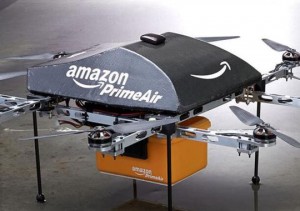Amazon Drone Delivery in 30 Minutes
In the 1980’s, Domino’s Pizza promised pizza delivery in 30 minutes or less. Although Domino’s eventually ended that promise, other companies have tried to emulate it. In the 21st century, companies like Amazon.com will use a different type of delivery system to meet that promise: unmanned drones.
 Last December, Amazon announced that it was planning to use unmanned flying drones to deliver packages in 30 minutes or less. Although the military uses drones in its operations over Iraq and Afghanistan, the technology has slowly expanded into domestic use. Drones have been used domestically for traffic enforcement, law enforcement surveillance, news gathering, and now, apparently, commercial delivery. If successful, the battery powered drones would allow Amazon to cut out middlemen like UPS or Federal Express.
Last December, Amazon announced that it was planning to use unmanned flying drones to deliver packages in 30 minutes or less. Although the military uses drones in its operations over Iraq and Afghanistan, the technology has slowly expanded into domestic use. Drones have been used domestically for traffic enforcement, law enforcement surveillance, news gathering, and now, apparently, commercial delivery. If successful, the battery powered drones would allow Amazon to cut out middlemen like UPS or Federal Express.
This announcement came as a surprise to the Federal Aviation Administration (FAA), which tightly controls the commercial use of drones in 2007. Although Congress required the FAA to create a new series of regulations for commercial use of flying drones in 2012, the FAA was not expected to announce any new rules regarding non-military domestic use of drones until 2015.
Amazon’s announcement changed the game. Congressmen from various states began asking the FAA if their states could develop the technology. On December 30th, 2013, the FAA relented and allowed six states, Alaska, Nevada, New York, North Dakota, Texas, and Virginia to open research sites to develop flying unmanned drones for commercial purposes. The states were chosen to test the drones in a variety of climates, geography, and air traffic conditions.
What’s the Worst That Can Happen?
There are a variety of ways a drone could malfunction. If the drone drops a package on top of a car or a child rather than a doorstep, Amazon will have to deal with that injury in addition to the customer’s loss of product. The drones will also have to share airspace with planes. Birds do substantial damage to a plane if a bird gets sucked into a plane’s engine. Imagine the fallout if a drone somehow got caught in an airplane’s turbine.
Amazon should also reconsider its promise about package delivery in 30 minutes. Domino’s Pizza discontinued its delivery promise in 1993 because of the number of personal injury cases arising from delivery boys causing accidents trying to meet the deadline. Although drones will be better drivers than teenagers and will be operating in a practically traffic-free environment, rushing delivery might lead to poor maintenance or other mistakes which could contribute to the accidents already described.
Aside from the personal injury issues, domestic use of drones could also raise privacy issues. The use of droves for package delivery probably won’t cause too much concern, but the potential abuses may be quite serious when drones are used commonly for law enforcement or journalism.
Obviously drone delivery isn’t a privacy threat, but the use of drones for law enforcement or journalism is a real concern. It might be hypocritical for Congress to talk about privacy issues from drones when it approves of NSA metadata collection, but questions regarding the information they might be collecting is a serious concern.


Comments